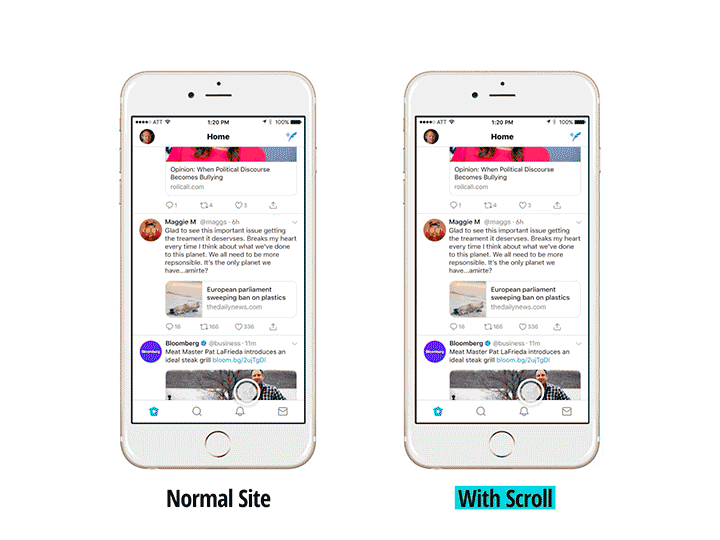|
Getting your Trinity Audio player ready...
|
Journalism shouldn’t be driven by clicks.
When you visit Scroll for the first time, the message above is softly hammered in. Before you can reach the main content, you have to click or tap, one word at a time, to properly absorb the entire sentence before you are greeted with…
The Silicon Valley quirkiness in the new journalism platform—launching for users in 2019—is easily explained when you consider who are behind it: a team of people from companies like Spotify, Google, Foursquare, Chartbeat, and Beme.
The CEO is Tony Haile, Founding CEO of Chartbeat, an Adjunct Professor of Media and Technology at Stanford University, and Board Member at the Lenfest Institute for Journalism.
Quirkiness aside, the question about the future of journalism remains….
If not clicks, then what?
With Scroll—the news startup which some are calling the Spotify for news—Haile is betting that he would be able to convince online news readers, subscribers and non-subscribers alike, to pay $5 a month (just like Medium) for a better, and an ad-free user experience on news sites they already frequent.
70% of the amount generated (after Scroll’s cut) would be distributed to publishers, based on the amount of time the consumer spends with their site.
For example, if a Scroll customer spends 10% of her time with a specific publisher, then that outlet would receive 10% of that customer’s subscription fee allocated to publishers, based on attention.
How would Scroll work?
In a recent blog post, the company explains, “An Internet built for us has content experiences designed for focus, not distraction. When you visit a Scroll partner, that site automatically recognizes that you are part of the Scroll network and delivers an experience purely designed for you.
There are no interruptive ads, no 15 second pre-rolls or links to baldness cures at the bottom of articles on the Supreme Court. An internet built for us cares about your privacy. You control your own data and can do what you want with it.”

“Scroll works automatically if you’re in mobile apps like Twitter, Reddit, LinkedIn or Facebook or just reading in Chrome on your laptop.
It seamlessly syncs content across your devices and is format-agnostic. You can start reading an article on a laptop, continue on your phone on the subway and then finish it as an audio story in your car.”
How would the user experience differ?
Tony Haile’s passionate take on Scroll is that it’s the company for that part of you that goes ‘yes journalism is important but goddammit if I have to wait 20 seconds for what turns out to be a clickbait vehicle for popup ads to load I’m going to punch something’.
“The way Scroll works is, you don’t have to change anything about what you do. You sign up for Scroll and then, whether you come to content from Facebook, Twitter or an email newsletter, the site loads, it’s beautiful, clean and ad-free,” says Haile.
Scroll’s stated mission is to “enable frictionless access to a thriving free press.” Given the reality that mounting pressure for fewer ad dollars is forcing media companies to compromise their content experience for revenue—with more interstitials, more pre-rolls, and slower page loads—Scroll is attempting to develop a platform that both provides great user experience and also funds essential journalism.
The model is designed to reward engagement and loyalty. We think those things are the currency of publishing in the future, that relationship with the consumer. The better you do at that, the better you do under Scroll.
Can the ad-free model really work for publishers?
Skeptics might point out that the mythical iTunes for journalism model has been tried before with little or no success. But with better technology and frictionless payment possibilities, there’s more excitement now, with a bunch of startups trying to connect publishers with reader revenue outside the boundaries of a strict subscription.
There’s LaterPay—a Munich-based company offering micropayments for publishers—which has been around for a few years and has some interesting success stories, like a blogger who made the equivalent of $24,000 in revenue using LaterPay.
The Netherlands-based micropayment platform Blendle (still in beta) lets users pay by the article, and already has a host of premium publishers on board, like The New York Times, The Wall Street Journal, The Washington Post, The Economist, and Time.
Invisibly, spearheaded and funded by the cofounder of Square, is another micropayments company with a bold new effort to revive the news business. Hundreds of content creators, including newspapers, magazines, and other media, have committed to launch with Invisibly.

According to Scroll, more than 60 publishers have now run thousands of scenarios through the Scroll model and the average revenue lift over what they would have made from advertising to Scroll subscribers is greater than 40%.
The initial group of publishers have demonstrated in beta-testing that it is possible and profitable to give consumers control over the experience they want, through a sustainable business model that has them make more money serving users than selling them.
Also, Scroll does not allow people to get around existing paywalls on sites, if they aren’t already paying subscriptions to those sites separately.
A number of publishers have signed up to be part of the Scroll network, including USA Today, MSNBC, Business Insider, The Atlantic, Fusion Media Group, BuzzFeed, Vox Media, Slate, The Daily Beast and more.
“Nobody has said no,” Haile said, of the publishers they’ve approached. But he says the real test is not about the number of publishers, but in the user experience.
The consumer doesn’t think about how many sites are in the network, but how much time they get to spend in a better experience.
“The big challenge of this business was always, ‘Can you get the publishers to come together where historically it’s not been in their nature to work together?’” Haile said. “All the major digital natives are now up and working with Scroll.”
Haile’s vision has garnered a lot of
“There’s been an overall shift toward subscription dollars and away from advertising dollars. The moment might be right, for that reason,” David Stern, Slate’s Vice President of Product and Business Development, says of Scroll.
“People are more interested in different revenue sources now, and not as focused on owning the whole pie. … There’s a sense that your success won’t come at the expense of our success.”
Haile sees Scroll not just as a new journalism platform, but as a step toward a better Internet world.
“There’s this newly reinvigorated focus on ‘how do we serve the consumer and put their experience first’,” he said.
Scroll is a symptom of that broader drive to put the consumer back at the heart of what we do as an industry again.
Time will tell whether Scroll gains traction or joins the legion of alternative payment models that whilst promising much, have – so far – failed to deliver for publishers in any meaningful way. It’s got a lot to live up to.


